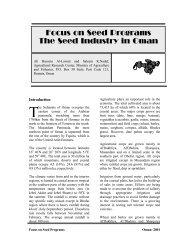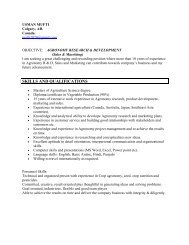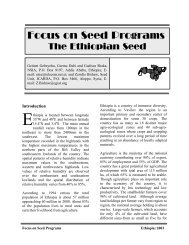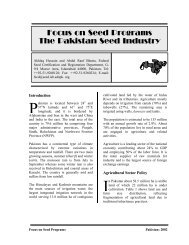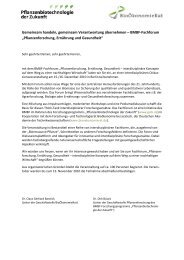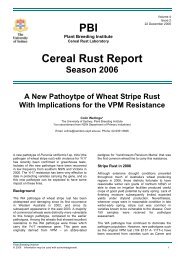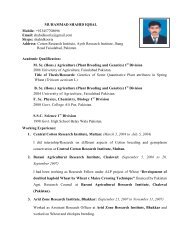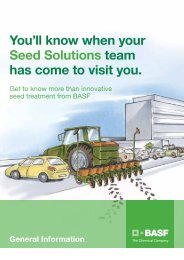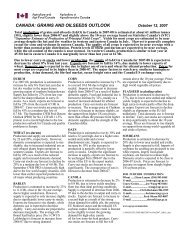Download newsletter - SeedQuest
Download newsletter - SeedQuest
Download newsletter - SeedQuest
You also want an ePaper? Increase the reach of your titles
YUMPU automatically turns print PDFs into web optimized ePapers that Google loves.
Seasons & Taste | October 2010 | 19<br />
4/<br />
Field Pack when Possible<br />
Field packing avoids double handling of the<br />
fruit (once in the field and again in the packing<br />
station) and therefore, reduces fruit damage,<br />
fruit losses and costs.<br />
These systems exist already for many crops<br />
or can be developed for most crops. The<br />
investments are not high, but they require<br />
well thought process changes.<br />
5/<br />
Maintain the Cold Chain Without<br />
Interruptions<br />
Interruptions in the cold chain are very detrimental<br />
for shelf life of fresh produce. Why? For two reasons:<br />
they increase respiration rate and shorten the<br />
shelf life of the product and they cause moisture<br />
condensation on the cold product, stimulating<br />
spore germination and disease growth. Exposing<br />
cold fresh product to warm moist atmospheres<br />
should be avoided by all means.<br />
6/<br />
Avoid Delays in the Packing Station<br />
A good production forecasting system in the field<br />
and an accurate inventory management in the<br />
packingstation will avoid peaks of production<br />
or accumulation of fruit in the packingstation.<br />
When fruit accumulates in the packingstation,<br />
it is not cooled fast enough, losing shelf life.<br />
Also it takes longer to dispatch and sell, so the<br />
fruit is losing shelf life already before shipping.<br />
A good forecasting system allows the sales team<br />
to prepare sales plans and promotions , therefore<br />
facilitating sales and good financial results.<br />
7/<br />
Ensure Good Air Circulation Through the<br />
Boxes qnd the Fruit, Not Around<br />
the Boxes<br />
Correct stowage is essential to proper cooling<br />
and shelf life preservation. Fruit activity<br />
increases exponentially with temperature.<br />
Cooling quickly and making sure field heat is<br />
removed from the fruit as quickly as possible<br />
is essential for good quality fruit at arrival.<br />
Therefore, a proper stowage is key, by making<br />
sure the cold air circulates around the fruit,<br />
removing field heat, and not as round the boxes.<br />
Each of these seven measures individually, when<br />
applied correctly, can result in productivity<br />
increases of 5-10% each. When several of<br />
these measures are combined, the benefits<br />
compound, resulting in increase in financial<br />
results of 20-30%. This occurs through a<br />
combination of savings and better sales.<br />
Source: www.fruitprofits.com<br />
If you would like to know more about this and similar<br />
topics that could benefit your fresh produce operation,<br />
check www.fruitprofits.com.<br />
The<br />
Beefsteak<br />
Tomato:<br />
A Developing Niche<br />
Among Tomatoes<br />
Lior Kushnir, Product Manager, Tomatoes, lior.kushnir@zeraim.com<br />
For years the traditional beefsteak tomato<br />
has been common in markets where the local<br />
cuisine is based on traditional products, such<br />
as Spain and Italy. These tomatoes are noted<br />
for their large (220–250 grams), fleshy, and<br />
multilocular fruit.<br />
In recent years Israel has begun exporting<br />
traditional beefsteak tomatoes to various<br />
markets, such as Eastern Europe, as a quality<br />
product. At the same time, a trend has emerged<br />
among growers to raise tomatoes of beefsteak<br />
size but uniform shape for local consumption.<br />
This trend is fed by clear profit motives—the<br />
larger the fruit, the heavier it is and the greater<br />
the farmer’s profit. For example, if five years<br />
ago the average fruit measured 67–77 mm,<br />
today it is 77–82 mm, and the demand for fruit<br />
larger than 82 mm is on the horizon.<br />
Thus the production of beefsteak tomatoes in<br />
Israel falls into two types, depending on the<br />
intended market:<br />
Local Market / The beefsteak tomato for the<br />
local market has big size and round smooth<br />
shape fruit. In other words, it is a standard<br />
tomato of the sort that Israelis know and love,<br />
only bigger. It is important to note that the<br />
basic qualities of the standard tomatoes—<br />
It is important to note that the<br />
basic qualities of the standard<br />
tomatoes—firmness and long<br />
shelf-life should be kept in these<br />
varieties. Many growers consider<br />
this type to be the solution for<br />
rapid growth with a higherquality<br />
harvest.<br />
firmness and long shelf-life should be kept in<br />
these varieties. Many growers consider this<br />
type to be the solution for rapid growth with<br />
a higher-quality harvest.<br />
Export / Beefsteak tomatoes for export are<br />
usually multilocular, this mostly because it is<br />
the market demand, but still they have to be<br />
firm with long shelf life in order to last the<br />
export journey. Israeli exporters are focusing<br />
on the Eastern European market.<br />
Zeraim Gedera has several varieties of<br />
beefsteak tomatoes, for both the local<br />
and export markets, in advanced stages<br />
of development and plans to bring<br />
them to market in the coming year.



